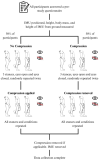The effect of a pelvic compression belt on postural stability in postpartum women
- PMID: 40772253
- PMCID: PMC12327193
- DOI: 10.1007/s12283-025-00516-5
The effect of a pelvic compression belt on postural stability in postpartum women
Abstract
The health benefits of physical activity are well known, however, for the postpartum population there are barriers to retuning to physical activity such as pelvic pain and a fear of movement. Pelvic pain can manifest from instability in the pelvic region and lead to impaired balance and postural stability, exacerbating fear of movement. This study aimed to assess the effect of pelvic compression on postural stability in postpartum women and a nulligravida control cohort. The participants' postural stability was measured using an inertial measurement unit, and the outcome measures JERK, mean velocity, trajectory area index, and root mean squared acceleration calculated, across two visual conditions (eyes open and eyes closed) during tandem and unilateral stances with and without the use of a pelvic compression belt. Significant improvements were observed, particularly in root mean square acceleration (p = 0.003) and JERK (p = 0.001), when a compression belt was used indicating enhanced postural stability, with the participants moving more smoothly and less intensely when maintaining balance. The effect of compression was highly individualised, suggesting pelvic compression could serve as an effective intervention to improve postural stability, though individual responses warrant a tailored approach for optimal results.
Keywords: Compression; Physical activity; Postpartum; Stability.
© The Author(s) 2025.
Conflict of interest statement
Conflict of interestAimee Mears is an Associate Editor of the Sports Engineering Journal. Rachael Vatter, Diana Segura-Velandia, and Isabel Moore have no conflict of interest.
Figures





Similar articles
-
Sexual Harassment and Prevention Training.2024 Mar 29. In: StatPearls [Internet]. Treasure Island (FL): StatPearls Publishing; 2025 Jan–. 2024 Mar 29. In: StatPearls [Internet]. Treasure Island (FL): StatPearls Publishing; 2025 Jan–. PMID: 36508513 Free Books & Documents.
-
Exercise for reducing fear of falling in older people living in the community.Cochrane Database Syst Rev. 2014 Nov 28;2014(11):CD009848. doi: 10.1002/14651858.CD009848.pub2. Cochrane Database Syst Rev. 2014. PMID: 25432016 Free PMC article.
-
Use of endoanal ultrasound for reducing the risk of complications related to anal sphincter injury after vaginal birth.Cochrane Database Syst Rev. 2015 Oct 29;2015(10):CD010826. doi: 10.1002/14651858.CD010826.pub2. Cochrane Database Syst Rev. 2015. PMID: 26513224 Free PMC article.
-
Pelvic floor muscle training for prevention and treatment of urinary and faecal incontinence in antenatal and postnatal women.Cochrane Database Syst Rev. 2017 Dec 22;12(12):CD007471. doi: 10.1002/14651858.CD007471.pub3. Cochrane Database Syst Rev. 2017. Update in: Cochrane Database Syst Rev. 2020 May 6;5:CD007471. doi: 10.1002/14651858.CD007471.pub4. PMID: 29271473 Free PMC article. Updated.
-
Non-surgical interventions for the management of chronic pelvic pain.Cochrane Database Syst Rev. 2014 Mar 5;2014(3):CD008797. doi: 10.1002/14651858.CD008797.pub2. Cochrane Database Syst Rev. 2014. PMID: 24595586 Free PMC article.
References
-
- World Health Organisation. Physical activity 2022. https://www.who.int/news-room/fact-sheets/detail/physical-activity (accessed November 8, 2022).
-
- Moore IS, James ML, Brockwell E, Perkins J, Jones AL, Donnelly GM (2021) Multidisciplinary, biopsychosocial factors contributing to return to running and running related stress urinary incontinence in postpartum women. Br J Sports Med 55:1286–1292. 10.1136/BJSPORTS-2021-104168 - PubMed
-
- Montgomery KS, Best M, Aniello TB, Phillips JD, Hatmaker-Flanigan E. Postpartum Weight Loss. 2012;31:129–38. 10.1177/0898010112464120. - PubMed
LinkOut - more resources
Full Text Sources
